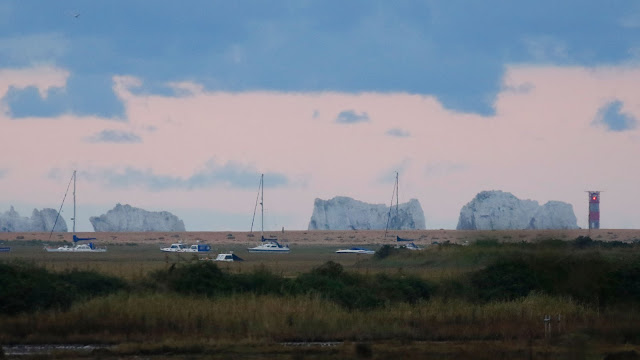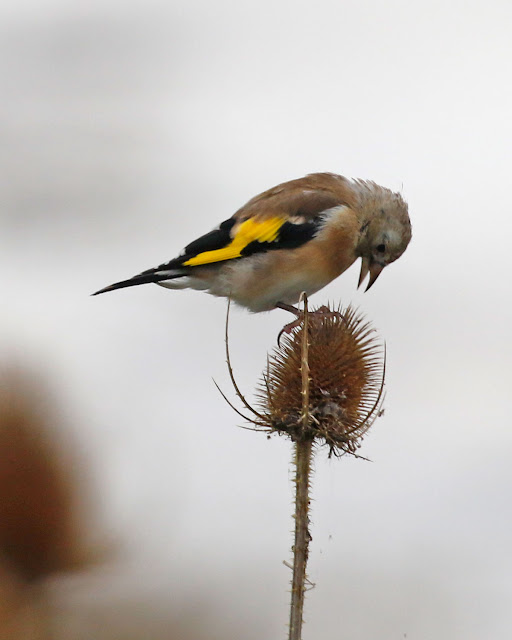Then as the sun finally broke above the horizon we were greeted with an explosion of red across the sky. It only lasted for a few minutes, but held the my attention for all that time
As I made my way back along the path for a second time there were several Whitethroats, and a few Blackcaps in the bushes, it also started to rain a little. Looking up at the clouds it didn't seem like it would be much.
As I walked up the sea wall I was greeted with an amazing sight, the morning cloud still had a break and the slowly rising sun was sending a truly magical light across the still water.
I walked closer as the Black-headed Gulls were using the old metal to perch on.
Back to the sea, and the exposed sand bars as the tide began to slowly creep up.
There were several Curlew in the lagoon, and a few Black-tailed Godwits. A smaller wader in comparison caught my eye feeding on one of the low banks, a Ruff.
Then a little further on a Knot, quite close to the sea wall feeding in the shallow water around one of the exposed islands.
Its not often that you get the chance to get close up to Knot, there seem to prefer feeding in distant flocks on the exposed tidal mud, or you see them in large distant flocks wheeling around over the water, at high tide, trying to find a dry roosting site or evading a possible attack from a Peregrine.
The Knot is much larger and more stockier than a Dunlin, with which they usually associate. In summer the Knot lives up to its full name, the Red Knot with a brick red breast and belly, but in winter plumage, it has an almost uniform grey plumage, with a thin wing bar and pale grey rump.
Juvenile birds have a slight peach wash on the breast, this is not the case here so this is probably an adult bird in full winter plumage.
Looking out to sea the early morning colour continued to create wonderful scenes, the white smoke from a distant chimney standing out against the still golden sea and sky.
As I approached Oxey Marsh the seaweed washed up onto the beach was moving, this was as a result of about twenty Turnstone rummaging their way through it, tossing the dried weed aside in the search for invertebrates. In amongst them was a single Dunlin.
Once again the water was totally still, providing mirror quality reflections of this Redshank.
Black-tailed Godwits feeding together.
A Dunlin, once again the reflection in the water.
And as one flies across the lagoon.
The cloud was shifting, and as it broke there would be shafts of light that was continuing to light up the sea. A flock of Grey Plover flew past, moving now as the tide was beginning to cover the exposed mud.
The sea wall had been very quiet with very few birds about, but as I walked around the path at Oxey Marsh the number of Meadow Pipits significantly increased, and as I walked I was moving up to thirty birds in front of me, moving from the path and grass edge to the bramble down towards the marsh.
And to the Gorse bushes.
As well as the Meadow Pipits there were also a lot of Goldfinches. The teasel was the main attraction and the large flocks consisted of both adult and juvenile birds. Here a juvenile, told from the adults by the lack of facial markings, but still very adept at extracting the fine seeds from the teasel heads
It was diving frequently, and came up with what looks like a shellfish. There were some frantic head shaking, probably in an attempt to break the shell to get to the flesh
Then it was gone
A Greenshank was feeding on the lagoon on the other side of the path.
As Turned along the seawall towards Moses Dock there was a Redshank standing in a pool of water, once again a lovely reflection in the dead still water.
From the dock I took the path around Oxey Marsh, there were birds in the bushes alongside the path. At first I could only find Great and Blue Tits, but then a slightly larger bird with a dipping flight, I followed it and immediately saw a flash of red. It flew into a bush and I was able to identify a male Redstart, but then as quickly as it appeared it was gone.
I walked on, searching the bushes, and stopping by the gate and hard standing area. There were lots of Linnets, Goldfinches, Meadow Pipits and a few Whitethroats, but I wasn't able to find the Redstart again.
Hirundines were now moving, but unlike last week, the numbers today were dominated by House Martins. They would swoop low over the marsh and around the bushes, but were all heading purposefully eats along the shore line.
As I approached the sea wall I picked up a Peregrine heading west over the sea, but was away from me before I could manage to get a good clear view.
Looking west towards Keyhaven over Pennington Marsh.
With the very still water I was looking for any opportunity to capture reflections. A Redshank was standing close to the far bank and reflecting into the water. I tried to get down to the same level as the water, but only managed to flush the Redshank, it flying off calling. There was though a Teal, and for a brief instance it looked up to see what had upset the Redshank, but then tucked its head under its wing once more.
As I approached the Jetty the Knot was still on the lagoon, this time feeding closer to the shore.
It was becoming a morning of reflection opportunities, yet another Redshank.
And a Black-tailed Godwit.
The tide was now well up, and there were people and dogs on the concrete jetty, so the Turnstone and Black-headed Gulls were using the old jetty metal work to roost on.
All the waders on Butts were distant, and without my scope it was difficult to go through them properly so I continued on, and stopped at Fishtail Lagoon for the juvenile Sanderling feeding along the water's edge of the main island in the middle of the lagoon.
Aged as a juvenile by the beautifully marked black and white patterns on the mantle and scapulars, distinct from the paler almost silvery white appearance of the adult in winter
After Fishtail lagoon it was Keyhaven, and as always all the waders and duck were at the far side of the lagoon! I found a couple of Pintail, and there were juvenile Shelduck beginning to acquire their adult plumage. In amongst a group of Grey Plover were some slightly smaller waders. I resorted to taking a long shot with the camera and zooming in to find they were Knot, six of them feeding with the plover.
I had presumably picked up the Peregrine I had seen earlier perched on a box in the Saltmarsh, it then flew off, but I watched as it returned to sit on the corner of the wooden box. You see so often reference to "the usual tree" or "in the same spot". This Peregrine seems to like this watch point, so now you know, this is "the usual spot".
Walking around the area, and even from the car park you can make out the Peregrine sitting there.
Walking towards Keyhaven harbour a Rock Pipit was feeding along the edge of the water, separated from the slightly smaller and slimmer Meadow Pipits by the more greyish plumage, less distinct streaking on the under parts and the dark legs
Over the Pans there was a large flock of Starling gathering on the wires above the water. Mostly juvenile birds getting there winter plumage, they would fly in and out dropping down onto the marsh land below.
The hoped for Kingfisher did not appear so it was off along the Ancient Highway, turning off to head up Iley Lane. Just past the balancing pond, where the path turns right then immediately left there was a flock of small birds. From the calls and brief views a few Long-tailed Tits, both Blue and Great Tits, several Blackcap and a couple of Chiffchaffs, one of which did show long enough for a photograph.
Walking back along the Ancient Highway there were more flocks of Starling over the disused tip. This flock seemed to be much bigger than the one at the Pans. They would fly up from the ground in a large, tight flock, and then drop once again out of sight, probably feeding on invertebrates in the grass.
A Raven sat on one of the posts watching the proceedings
Back at the car park there was another huge flock of Starlings, the biggest yet. They would alternate between the berry laden bushes and the marsh, not being able to settle on a good spot. Scanning through them did not produce the hoped for Rosy Starling.
The cattle had moved from the main marsh to just close to the car park, and over lunch there were Yellow Wagtail dropping in amongst them, frustratingly a handful of roll meant I wasn't quick enough with the camera. Annoyingly a group of dog walkers then passed by the cattle and the wagtails were off. Walking through the cows after lunch did not relocate them, although one did fly over calling.
On Fishtail the Sanderling was still present, this time on the long thin island that was a little closer to the path.
While at the back of the lagoon there was a single Spotted Redshank.
Walking around to Butts Lagoon, there was a single Snipe feeding with Dunlin and Lapwing. Still looking out for Yellow Wagtails walking through the cattle on the old Tip did not find any.
Just before reaching the car park I noticed a small group of cows on Pennington Marsh walking towards the tip. With them were small yellow birds. The cows kept coming, and with them the Yellow Wagtails, would the cows bring the wagtails even closer?
The answer was no. The cows kept coming, but the Yellow Wagtails, at least a dozen of them flew up and up and banked away back over the marsh and out of sight. There were no further cows in the field so it was to wonder where they went.
It was now decision time. The birding had not been wonderful, but it was always possible something could turn up (which it did!). There had been a Temminck's Stint at Titchfield Haven all week, typically being reported in the afternoon. So it was this in mind when I pulled up at the sea wall at Hill Head about an hour later.
The same Little Grebe as last week at the bridge as I went to purchase my permit?
It was not to be though. From the Meon Shore hide two Green and Common Sandpipers and this Ruff.
While from the Pumfrett Hide the only interest was a nicely silhouetted Snipe.
It has been a strange autumn so far, none of the numbers of expected birds or the attraction of the rarer ones. Surely it should pick up soon
























































No comments:
Post a Comment